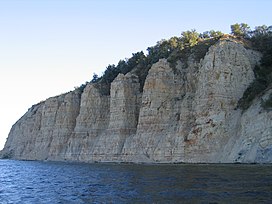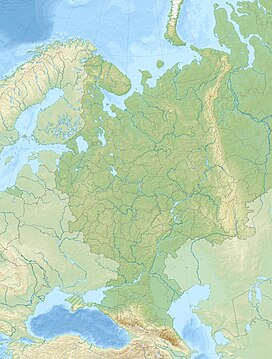Volga Upland
| Volga Upland | |
|---|---|
| Приволжская возвышенность | |
 Stolbichi wall on the banks of the Volga | |
| Highest point | |
| Peak | Unnamed |
| Elevation | 381 m (1,250 ft) |
| Dimensions | |
| Length | 800 km (500 mi) NNE/SSW |
| Width | 500 km (310 mi) ESE/WNW |
| Geography | |
| Location | |
The Volga Upland, also known as the Volga Uplands, Volga Hills,
The uplands lie in the cool continental climate zone, characterised by large fluctuations in seasonal temperatures and generally little rainfall. Outside of the cities in the region, population density is generally between 28 and 129 inhabitants per square mile.
Geography
The uplands run for approximately 800 kilometres (500 mi) in a southwest-northeasterly direction from Volgograd to Kazan. The Tsimlyansk Reservoir lies at the southwestern end of the Volga Upland, with the Kuybyshev Reservoir at the northeastern end.
The landscape on the Volga Uplands is hilly, and several rivers have cut into it, such as the
The Volga Uplands themselves are rather sparsely populated, but along their edges and in particular along the banks of the Volga there are several large cities, such as (from north to south) Kazan, Ulyanovsk, Saransk, Penza, Syzran, Saratov and Volgograd.[4]
Subranges
The hill ranges along the Volga banks are traditionally called mountains (горы), despite being of low height. The main ones are:
- Uslon Mountains
- Yuryevy Mountains
- Bogorodskye Mountains
- Syukeyevo Mountains
- Tetyushi Mountains
- Undory Mountains
- Zhiguli Mountains
- Khvalynsk Mountains
- Don-Medveditsa Ridge
See also
- Highest points of Russian Federal subjects
- List of mountains and hills of Russia
- Taw yağı
References
- ^ Google Earth
- ^ "Volga Hills." Columbia Gazetteer of the World Online. 2009. Columbia University Press. 06 Feb. 2009. [1]
- ^ "Приволжская возвышенность". Great Soviet Encyclopedia.
- ISBN 978-0-7894-4604-6
External links
 Media related to Volga Upland at Wikimedia Commons
Media related to Volga Upland at Wikimedia Commons


